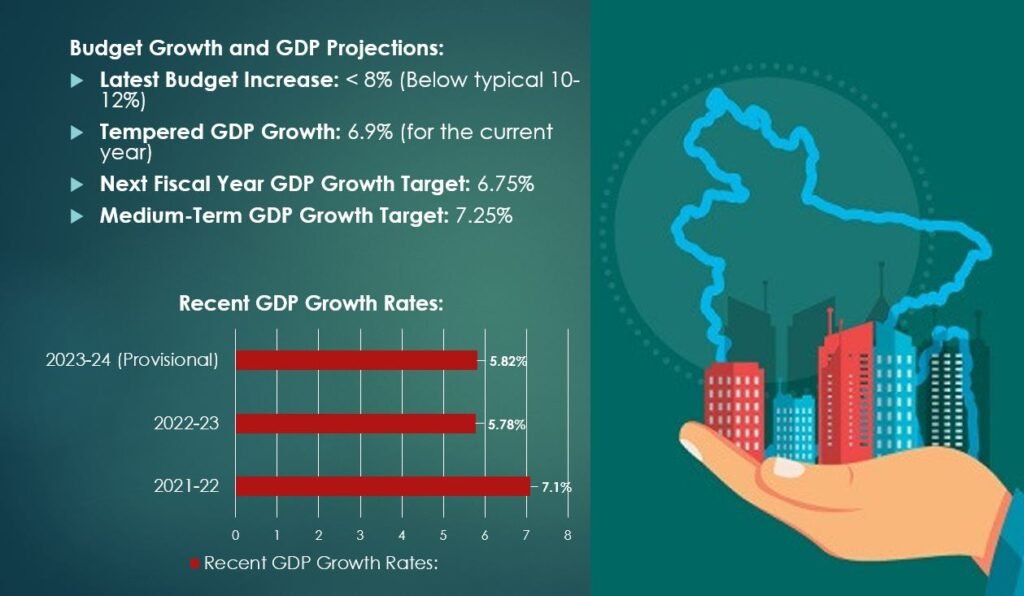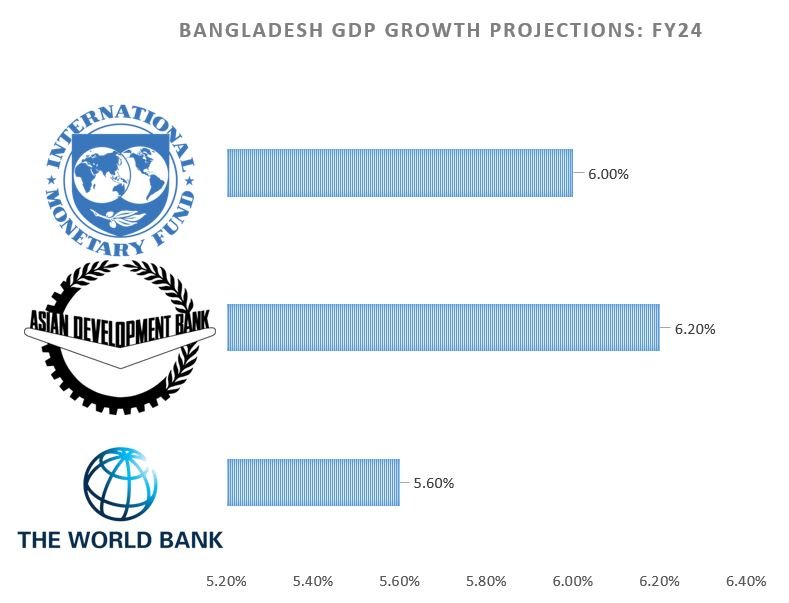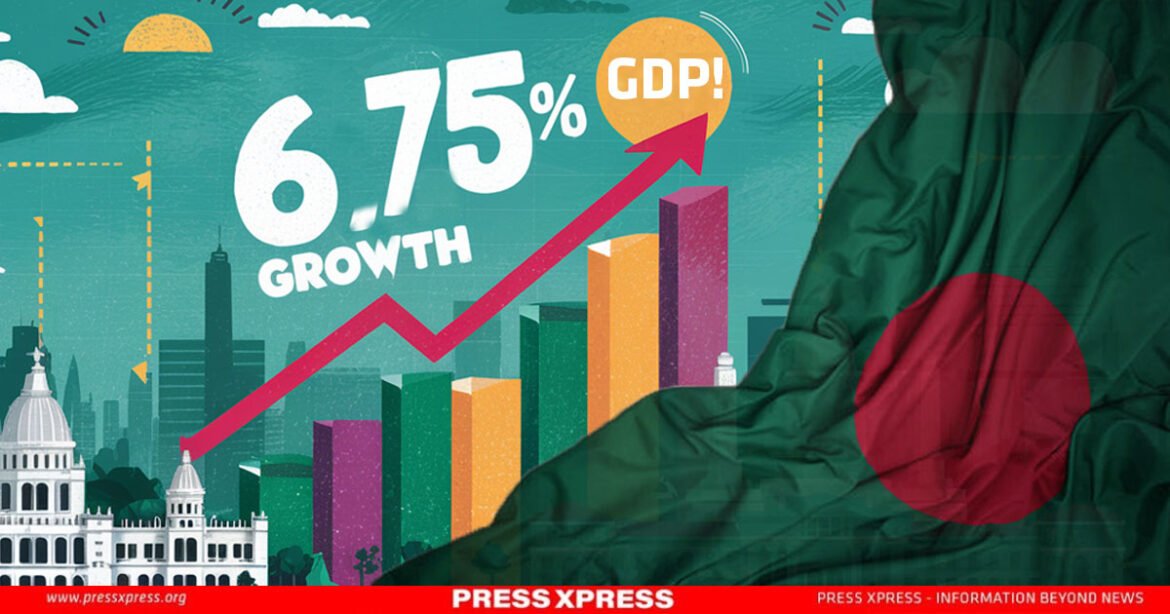The government’s optimism shines bright as it sets its sights on a soaring GDP growth rate of 6.75% for the fiscal year 2024-25. This ambitious projection, nearly one percentage point higher than the outgoing year, stands as a testament to the resilience and determination of the nation’s economic agenda.
You Can Also Read: National Budget: Tk 7,97,000 crore for FY2024-25
Despite navigating through the labyrinth of a contractionary monetary budget, the government remains steadfast in its commitment to tame the flames of inflation. The recent projection by the Bangladesh Bureau of Statistics, foreseeing a GDP growth of 5.82% for the current fiscal year, sent ripples of concern. However, after meticulous scrutiny and review, the finance ministry anchored the target at 6.5%, a move reflective of their unwavering dedication to economic stability.
In a momentous unveiling before the Parliament on June 6th, 2024, Finance Minister Abul Hassan Mahmood Ali laid bare a Tk7,97,000 crore national budget for the fiscal year 2024-25. This pivotal moment, orchestrated with precision, underscores the government’s strategic approach to combating inflationary pressures.
54th Budget: A Steadfast Vision for Sustained Economic Growth Amid Global Challenges
Prime Minister Sheikh Hasina’s nod to the budget’s magnitude in May set the stage for this transformative fiscal endeavor. Yet, the unveiling of the latest budget, adorned with a tempered GDP growth of 6.9%, marks a departure from conventional expectations. Typically, the size of a new budget burgeons by 10% to 12%, but this year’s increment falls shy of 8%, signaling a nuanced approach towards economic stewardship.
As the 54th budget of the country unfurls its narrative, the government’s unwavering gaze fixates on the pinnacle of progress. Finance Minister AH Mahmood Ali, in his address at the Jatiya Sangsad Bhaban, articulates the vision with resounding clarity. “It is expected that pursuing all the prudent policy measures will help achieve GDP growth of 6.75% in the next fiscal year and 7.25% in the medium term,” he proclaims, echoing the nation’s aspirations for sustained economic vibrancy.
Amidst the backdrop of global turmoil, the nation’s GDP growth continues its steadfast ascent, propelled by the implementation of prudent and appropriate policy measures. From the annals of history, where the average growth rate between FY 2009-10 to 2022-23 stood at 6.71%, to the pinnacle of achievement witnessed in FY 2018-19 with a record GDP growth rate of 7.88%, the resilience of the nation stands tall against the backdrop of adversity.

Ali’s words reverberated with resolute optimism amidst the tumultuous global landscape. “Despite the tempests unleashed by the Russia-Ukraine conflict and other global upheavals,” he declared, “Bangladesh has defied odds, achieving a remarkable 7.10%, 5.78%, and 5.82% (provisional) growth in 2021-22, 2022-23, and 2023-24 respectively—a testament to the indomitable strength of our economy.”
However, maintaining this triumphant stride into the future requires unwavering commitment, Ali emphasized. “We shall continue to extend all reasonable supports, fostering agricultural and industrial production,” he vowed, his voice a clarion call to action.
World Bank and UN Project Modest Growth for Bangladesh
Yet, amidst the backdrop of such stalwart determination, a shadow loomed. The World Bank, bearer of forecasts, tempered the fervor with a somber note. A reduction by a mere 0.1 percentage point, yet laden with weight, cast a pall over Bangladesh’s economic horizon for FY2025.
The reasons were as myriad as they were daunting: inflation’s relentless ascent, the specter of resource shortages, the chains of import restrictions, and the vulnerabilities of the financial sector. Each a challenge, each a potential stumbling block on the path ahead.
Nevertheless, amidst these storm clouds, a glimmer of hope endured. The current fiscal year, despite the tempest’s fury, stood resilient, maintaining a growth projection of 5.60%. The words of the World Bank’s Bangladesh Development Update report unveiled in Dhaka, echoed a resilience reminiscent of Ali’s own resolve.
And beyond the borders, in Sri Lanka, where another chapter unfolded, the WB’s South Asia Development Update breathed life into regional aspirations, elevating economic growth projections to 6.0% for FY2024 and 6.1% for FY2025—a beacon of optimism amidst the prevailing uncertainty.

The stage was set with the unveiling of the UN’s esteemed economic report, “World Economic Situation and Prospects (WESP) 2024,” a beacon of insight illuminating the path forward. Released on January 4th, 2024, it bestowed upon Bangladesh a glimmer of hope—a projection of slightly improved economic growth, standing resilient at 5.8% for FY25. This revelation echoed in harmony with the World Bank’s steadfast forecast from the previous October, a testament to a shared vision of progress.
But amidst these economic crosswinds, the narrative took a dramatic turn. In December 2023, the Asian Development Bank (ADB) wielded the blade of recalibration, cutting the growth forecast for Bangladesh’s economy to 6.2% for FY24. Preceding this blow, the International Monetary Fund (IMF) had already marked the nation’s economic growth projection down to 6% for the current fiscal year.
South Asia’s Mixed Economic Future
The UN report cast a shadow over the economic landscape, its pages fraught with warnings of challenges ahead. Persistently high interest rates, the ominous specter of conflict, sluggish international trade, and the haunting reality of climate disasters all coalesced to paint a somber tableau of the near future. “In Bangladesh, real GDP growth is expected to slow in 2024,” the report lamented, contrasting starkly with the promise of growth sprouting forth in Nepal.
The UN’s press release highlighted global economic challenges like weakening trade, high public debts, low investment, and geopolitical tensions. Despite these issues, South Asia is expected to show robust economic growth of 5.2% in 2024, driven by India’s strong performance. However, financial constraints and fiscal imbalances pose risks to the region’s growth. Additionally, geopolitical tensions, from the Ukraine conflict to unrest in Western Asia, make South Asia vulnerable to oil price fluctuations and uncertainty.
Economic Challenges Ahead
- High interest rates
- Conflicts and geopolitical tensions
- Sluggish international trade
- Climate disasters
Amidst uncertainty, nature added to the challenges with the looming return of the El Niño climate phenomenon, threatening economic stability. However, the UN projected some relief with a gradual easing of inflation in South Asia. Bangladesh, in particular, showed promise, with inflation expected to drop to 6.8% in 2024 from 9.6% the previous year, signaling potential economic stability despite the ongoing threats.
The report warned of potential disruptions from commodity price hikes and extreme weather, risking progress and increasing food insecurity. Amidst this uncertainty, UN Secretary-General António Guterres called for bold investments to drive sustainable development and climate action. “2024 must be the year we break out of this quagmire,” he urged, emphasizing the need for significant investments to achieve robust, resilient growth.


